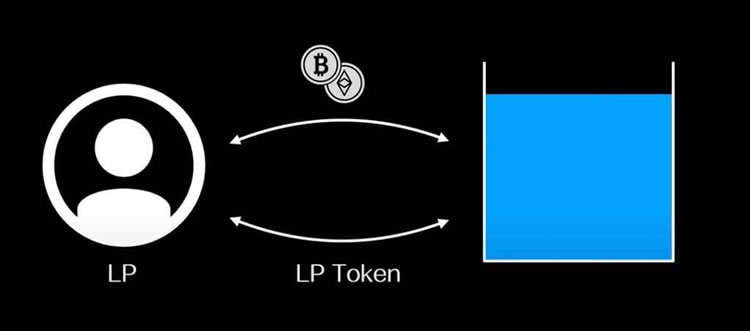Automated market makers are a type of decentralized exchange that rely on algorithms to determine the price of digital assets and use pairs of exchangeable assets. These protocols are actually based on smart contracts that automatically set and provide the trading price between two digital assets. Therefore, these assets will be automatically exchanged between them based on algorithms, rather than based on order books as in traditional finance. Therefore, the entities participating in this exchange only interact with this smart contract and not with each other. Automated market makers are still important in DeFi. Many investors may still not know how this automatic market maker makes money? Let me analyze it for you below.

An automated market maker (AMM) is a mechanism used in decentralized exchanges (DEX) that automatically calculates transaction prices between assets through algorithms.
This mechanism allows automated transactions of crypto-assets and other digital assets without permission. The decentralized nature means that there is no third-party intermediary involved, reducing transaction costs and improving transaction efficiency. Automated market makers operate by setting up liquidity pools that store a certain amount of an asset and are used to match orders from buyers and sellers, with algorithms determining prices based on the amount of assets in the pool and trading demand. This decentralized market-making model solves some problems of traditional exchanges, such as transaction slippage and transaction efficiency, but it also brings some new challenges, such as how to ensure the accuracy and security of the algorithm.
Most market makers in the market are large economic players. Market makers maintain market liquidity and make profits by buying and selling securities based on open market quotes. In addition to profits from the bid-ask spread, market makers also receive an additional source of revenue from commissions on liquidity provided by the exchange.
1. Bid-Ask Spread
For investors who want to trade quickly and in large quantities, the trading party is likely to be a market maker. Investors must pay a little more to buy or sell at a lower price to ensure a smooth transaction. At this time, the price between buying and selling becomes the profit of the market maker. Of course, this profit is very small and cannot be earned by anyone except the market maker. In addition to this, market makers need to be able to ensure that they can still hold profits in the event of a price dip or two, for example, by providing exemptions from market maker fees or even subsidizing their fees.
2. Liquidity Commission of the Exchange
The exchange needs trading volume to make trading popular and the exchange to earn fees from it. Therefore, the exchange needs the participation of external market makers to ensure that the various financial instruments on its exchange have sufficient liquidity. There are many different forms of participation, often with fee waivers. After reaching a certain trading volume, the exchange will provide more fee reductions and additional commissions. Conversely, if a market maker does not reach a certain trading volume specified by the exchange, it will be notorious for terminating its interest in the relationship.
Now that you know what a market maker does, you may be eager to explore an automated market maker account explained in detail. Decentralized exchanges focus on eliminating all intermediary processes associated with crypto trading. DEX does not provide any support for the hosting infrastructure or order matching system.
Therefore, DEX users can enjoy a considerable degree of autonomy and initiate transactions directly through their non-custodial wallets. However, the most interesting aspect of decentralized exchanges is the replacement of order matching systems and order book models with autonomous protocols called autonomous market makers, or AMMs.
In the most basic sense, an AMM or Automated Market Maker is basically a protocol, algorithm or formula that helps in pricing assets. Rather than employing an order book model like traditional exchanges, automated market maker algorithms help price assets. Additionally, you should also note that the formula for AMM may vary for each protocol.
For example, Uniswap’s automatic market maker formula is “x*y=k”. In this formula, “x” represents the amount of a specific token in the liquidity pool, while “y” represents the amount of another token in the liquidity pool. The “k” in Uniswap’s automated market maker formula represents a fixed constant in the equation. The fixed constant "k" clearly indicates that the total liquidity in the pool should always remain constant.
Interestingly, you can find different automated market maker algorithms in another AMM, depending on its specific target use case. On the other hand, all AMMs have one significant similarity between them, namely the fact that they use algorithms to determine asset prices. AMMs can help decentralize the process of getting good prices on crypto assets, allowing any individual to create their own market on the blockchain network. Some famous examples of AMM crypto exchanges include Curve, Uniswap, and Balancer.
I hope investors can understand how automatic market makers make money through the above article. The main way AMM works is to emphasize the primary reason why attracting liquidity is important. A higher level of liquidity in the pool ensures limited potential for slippage on large orders. Therefore, improved liquidity may play a key role in driving increased trading volumes on the platform. It is also important to note that slippage issues can vary significantly depending on the AMM protocol. Automated market maker formulas help determine prices. This formula shows how much the ratio between tokens in a liquidity pool changes after a specific trade. If the ratio changes dramatically, you have to worry about slippage being too high.
The above is the detailed content of What does automated market maker mean? How do automated market makers (AMMs) make money?. For more information, please follow other related articles on the PHP Chinese website!




